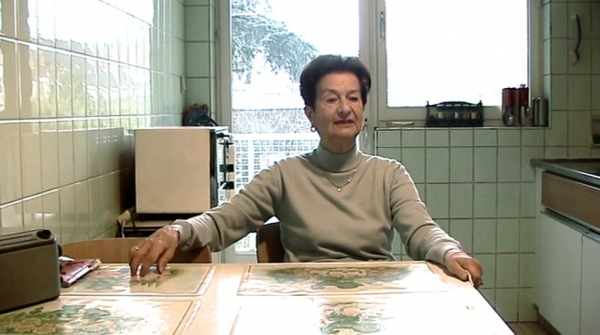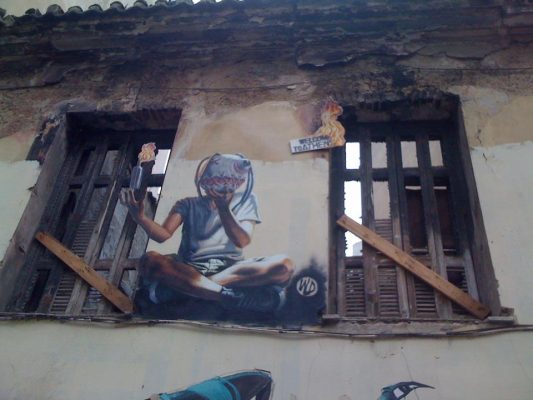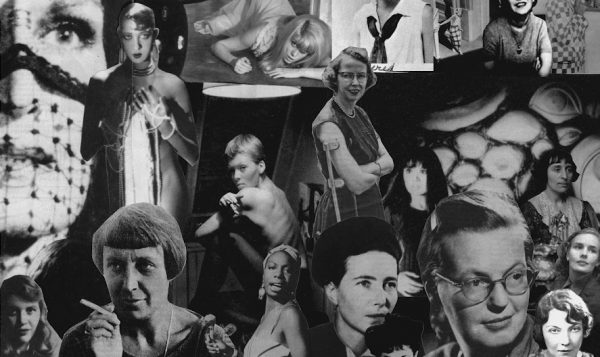There’s a scene in the documentary I Don’t Belong Anywhere, about the Belgian filmmaker’s Chantal Akerman’s life and work, where she discusses her only foray into commercial filmmaking, the William Hurt and Juliette Binoche vehicle, A Couch in New York. She and Hurt butted heads (even in this short anecdote you can sense her quiet obstinacy, her absolute refusal to bow to Hurt’s celebrity); nobody saw it and those who did, didn’t like it; it was, by any metric, a failure. Critics took issue with both the romantic and comedic aspects of the film – a problem for a romantic comedy. Akerman handles it with trademark good humour. There are no scores to settle here, no grievances to unload, although the viewer must understand, perhaps now more than ever, the intense private battles Akerman must have fought to survive as an artist. Certainly, Akerman possessed the singular vision, marvellous self-sufficiency (she made her first film when she was eighteen; she made another in just one week), attention to detail, and strong will we idolise in male auteurs; traits, for example, more recently venerated in Quentin Tarantino. The scene concludes with Akerman seated defiantly in a diner, refusing to be embarrassed or humiliated by the box-office takings of a film about an unlikely couple brought together by an apartment swap. There’s a slight air of mischievousness about her, a mutinous part of her that finds it amusing that the film was made at all, that they actually allowed her to make it. Well, what was her great failure? The truth is Akerman couldn’t, even if she tried, – and the punchline is she did try – make a dumb movie.
My Mother Laughs isn’t a memoir — no sign of Jonas Mekas, no brief, holy appearance of Agnes Varda, hardly any reference to her film career. It’s a further step in her complex self-representation project, which began in 1968 with the short film Saute Ma Ville and continued with her installation work, as she endeavoured to blur the boundaries between life and art until her death in 2015. My Mother Laughs — elegantly translated by Daniella Shreir, and containing several personal photographs and stills from her films — is a more intimate undertaking than strict autobiography. The only real mention of Akerman’s work is, of course, mediated through her mother. ‘My daughter on the other hand,’ her mother tells a carer, ‘she goes all over the place to show her films.’ There is a note of melancholy attached to this offhand phrasing for Akerman’s mother is ill, apartment-bound, captive in her own body, her only company a troupe of daily carers. She ticks off the places her daughter has travelled to: Japan, Cambodia, China. In China, she tells us, Akerman caught a tapeworm. ‘Her daughter,’ she says, ‘never pays attention so things happen to her all the time.’ In the writing of this book, Akerman proves her mother wrong in that respect, although, considering their bond, I doubt this was her intention. My Mother Laughs is a sustained, committed burst of attention, precise and informed by great love. Formally, it resembles the still, long shots of New York from her film News from Home in its refusal to look away, in its insistence that everything – everything – within the frame is interesting. Most strikingly, it’s free of all ego. Akerman, who experienced difficulty talking about herself in interviews, has no desire to impress her skills upon the reader. Instead she deals with a particularly feminine reality, in this case caring for an elderly parent.
There is conflict in the family home and there is conflict within Akerman herself. She wants her mother to live but she struggles to cope with her in her present condition. Her current state of helplessness is impossible, but the thought of losing her is fatal. ‘My mother might well have died,’ she writes, ‘and even though I had said I was ready I don’t really think I was.’ Their days together are dominated by quiet routine: list-making, cooking, occasionally eating in a local restaurant. In a poignant section she describes her mother’s trips to the hairstylist down the street, how, even at this late stage, vanity still persists. Her mother has been advised to grow out her hair; she attempts a little fringe. Akerman chastises herself for her lack of patience with her mother, for hiding herself away in her bedroom and cutting off conversation. ‘Then I tell myself that she’s entered the room because she wants some human contact and I can understand that perfectly. I’ve always understood that sort of thing.’ Her mother’s past, her time in a concentration camp and the unspoken torture inflicted upon her there, lurks silently in the background. Akerman, as a result of her mother’s childhood, was obsessively haunted by the Holocaust. She is haunted in other ways now too – by a mother figure who is disappearing and being replaced by someone needier and more severe. The woman who saved to send her daughter money when she was alone making News from Home is receding from Akerman’s memory. She writes:
We can’t remember. We can’t remember the good times anymore. We can’t remember how our mother was before. We can’t remember how she looked after us. We can’t remember that it was thanks to her that there was joy in our house.
Although overwhelmingly aware of her duties as a carer, Akerman can’t adapt to her new role. Then again, how could the woman who made Jeanne Dielman ever slip naturally into a domestic routine? There are traces of her essential 1975 film about a single mother’s menacingly regimented schedule in My Mother Laughs: her unforgiving knowledge of how chaos can emerge from domestic powerlessness; how easily and likely it all is to collapse. She writes:
And it’s been made clear that it’s better for me to do nothing or else it might end in disaster. A real disaster. Like breaking a cup, knocking something over, staining the tablecloth, dropping the tray, or worse.
Akerman’s mother is more than merely glimpsed: she is understood. A strong character who – having endured the defining horror of the twentieth century – had no choice but to be strong. Still Akerman was never ‘normal’, not in the strict, hostile meaning of the term, and the mother couldn’t manufacture a new identity for the daughter. Akerman’s mother had to watch her daughter disregard her stability and happiness for her art again and again. There is the gap between the life you want for your child and the one they eventually discover for themselves. The mother is as equally conflicted as the daughter. She cuts out all the articles about Akerman’s films from newspapers and keeps them. She wishes her daughter would brush her hair more frequently.
Running parallel to her mother’s decline is Akerman’s shadowy relationship with someone referred to only as ‘C’. From the scant details Akerman provides you discern C is younger, territorial, perhaps seeking a mother figure to replace her own deceased mother. They meet on Facebook in a section that perfectly evokes new flickers of desire with a near-stranger, intimacy through a computer screen (it also called to my mind the Skype sessions Akerman has with her mother in her final film No Home Movie, her mother’s pixellated face uncomfortably close to the camera, uncertain of the new technology). She writes of their early exchanges:
I was starting to live again. I would wake up excited, full up with what we’d said to each other the night before. I would go to bed reading the poems she’d sent me, after sending her anecdotes and songs, and I remember thinking that sending poems and songs is something you do at fifteen but still I would listen to the songs on repeat and sing along, especially to ‘My Funny Valentine’ and ‘Bang Bang’. Those were the sad songs I would sing along to at the top of my voice.
Akerman slowly begins to regret meeting C and wishes she had left their relationship online, idealised and unexplored. After a few tentative months of precarious togetherness (‘we would watch TV and films, the films that we’d ordered on the TV. When we watched films we managed to live. Films are what we needed to live’) their relationship dissolves into jealousy, paranoia, bitterness and, in Akerman’s case, long bouts of insomnia. The violence, when it comes, is sudden, like in Jeanne Dielman but, when you consider what came before, not totally unexpected. Another crushing weight to Akerman is her lack of productivity, the result of the deadening effects of her and C’s consuming relationship: ‘I’m not saying that C prevents me from writing or that I prevent her from writing… but there’s something that prevents us when we’re together.’ Akerman is perceptive enough to recognise her own difficult behaviour, stemming from what she frankly refers to as her illness, an illness, she states, which is as ordinary and everyday as any other.
Akerman had her first manic episode at thirty-four, an event she described in ‘The Pajama Interview’ in LOLA Journal as a slow shutting-down, the lights going out in a house. ‘Previously I had felt a kind of energy in life; with moments of depression of course – but I read constantly, took notes, was curious about everything. Then it was gone. The breakdown knocked me out.’ She committed suicide in the autumn of 2015, not long after her mother’s death. If you trawl through obituaries, the phrase, ‘in light of her suicide’ appears frequently, as if her entire body of work can now only be judged through the prism of her death. It’s a mode of thinking I find – and I’m searching for the right word here – repulsive, as if her entire filmography is a cadaver to be cut open and ransacked for clues.
It’s the wrong way to approach this book. There are personal and societal reasons for her depression. She writes about growing up as a lesbian, about constantly being abandoned for men, about how her sexual identity marked her as an outsider from the start. There are sections of the book, as Akerman sleepwalks between Paris, Brussels and New York, that reminded me of the acute loneliness conveyed in her 1978 film The Meetings of Anna. Essentially about a filmmaker on a publicity tour, The Meetings of Anna is all you need to watch to be convinced that the airport lifestyle, which is bizarrely held up as a modern-day aspiration, is a lie. Akerman articulates the terrible, gnawing feeling of not knowing what you will discover when you land in the countries where you’ve constructed half-lives, half-homes. ‘But I didn’t want to land anymore,’ she writes, ‘I wanted to spend the rest of my life on the plane.’ On re-watching The Meetings of Anna, it’s impossible not to see the actress Aurore Clement for what she was: an Akerman stand-in. There are the obvious, devastating scenes, such as when Anna tells her mother about the genuine moment of intimacy she had with a woman; the looping voicemail in the closing sequence; the cold, faceless instructions delivered by telephone. But on repeat viewing I found the smaller moments more difficult to watch. It’s hard not to picture Akerman in these bland, bare hotel rooms, jet-lagged, medicated, drawing the curtains for bed, too clever not to know that this was essential – she had to work twice as hard to be taken half as seriously, and to get an inch of the recognition afforded easily to her male contemporaries.
Despite self-diagnosing as lazy and sloppy, her dedication to her work is never in doubt. The short sections where she describes returning to filmmaking pulse with excitement and joy. ‘I absorbed myself in other things, like making a film, and I stopped feeling hurt about everything. I was so absorbed that I became happy.’ Admittedly capable of making prisons for herself wherever she went, Akerman found all the necessary freedom in her work. In My Mother Laughs she reserves the full extent of her ire and hatred for the privileged girls’ school she attended for a spell as a teenager. (‘But I think’, she writes, ‘the most educated people are also the most hypocritical.’) Her disgust at this level of privilege, and the smooth lineage of this privilege, is the writing of Akerman the socially-conscious artist, the director who made Sud, a film about the hate-killing of James Byrd Jr. in Texas. ‘Power,’ she says in ‘The Pajama Interview’, ‘has no soul. You can’t be surprised by anything.’ Her selflessness, this time as a daughter, comes to the fore again in perhaps the most painful section of the book, as she describes her mother and father coming to visit her in the clinic where she has been locked up:
I could see them walking side by side in the fog of the big park. They looked so small in the fog. When I’d seen them like that, from a distance, I thought to myself I’ll put on a brave face. I knew that they were struggling. That they were struggling with having a daughter who was locked up in a clinic. Yes, I had to put on a brave face.
That My Mother Laughs is so well-written is unsurprising as many of Akerman’s films began as unpublished short stories and novels. What is a surprise is how vulnerable the book is – not commodified vulnerability, the kind where a work has been examined from every possible angle to make sure the writer still remains appealing even when exhibiting their worst traits – but frighteningly unguarded. It’s a risk from a woman whose career was defined by risks. Akerman eschewed all labels, including that of a feminist filmmaker, and My Mother Laughs can be seen as the final word on how she would like to be remembered – simply, as a daughter who paid attention.




